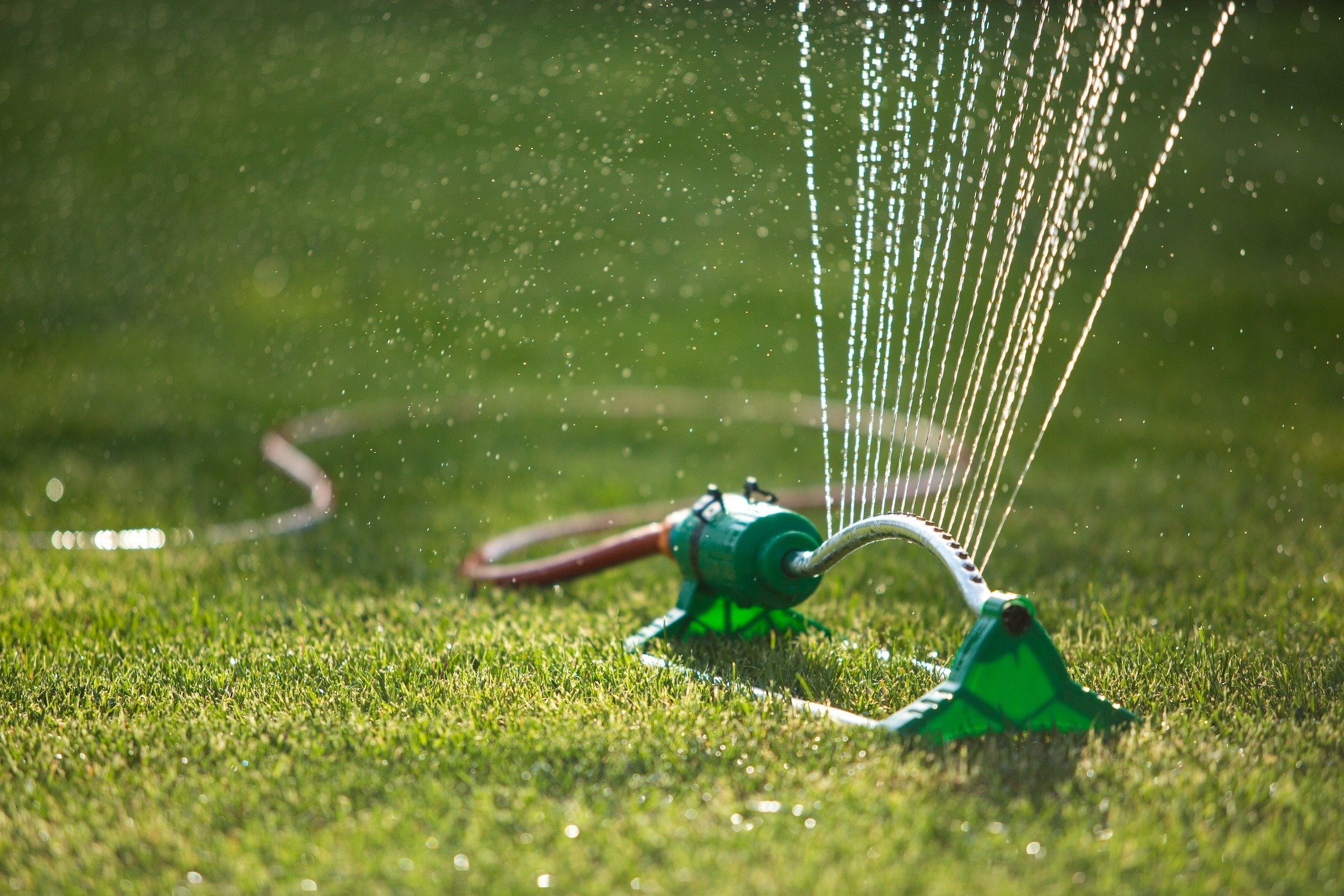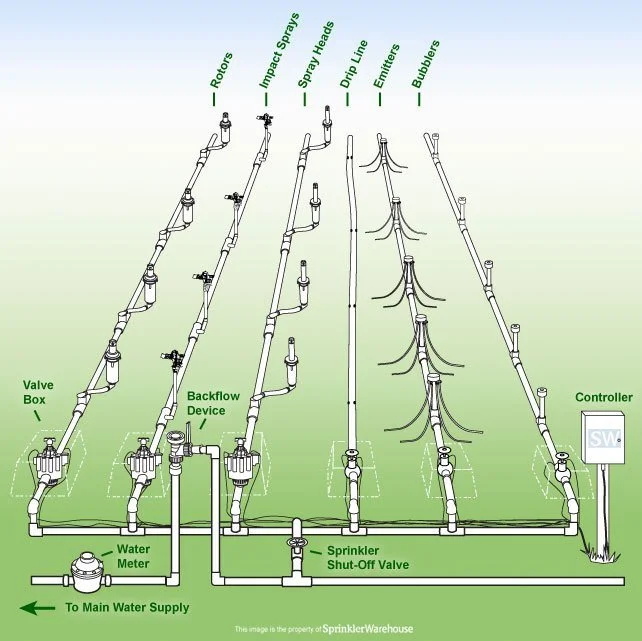Discovering one of the most Usual Problems in Lawn Sprinkler Equipments and Their Repair works
Automatic sprinkler are important for keeping healthy landscapes, yet they usually run into various troubles. Common concerns include blocked nozzles, busted pipes, and irregular watering patterns. Each of these can markedly influence system performance and water efficiency. Recognizing these troubles and their options is vital for any type of property proprietor. The complying with sections will certainly lay out common obstacles and the essential repair work to maintain an automatic sprinkler working at its best. What follows may shock those not really prepared for maintenance realities.
Clogged Nozzles and Sprinkler Heads
Blocked nozzles and sprinkler heads are typical concerns that can substantially prevent the performance of a lawn sprinkler. Over time, debris such as mineral, dust, and algae build-up can accumulate, obstructing water flow and resulting in unequal insurance coverage in the lawn or garden. This can lead to particular locations obtaining insufficient water, while others might become over-saturated.
Normal upkeep is essential to stop these obstructions. Regular checks can recognize any obstructions, and cleaning can typically be completed with easy devices like a tiny brush or a toothpick. In many cases, soaking blocked components in vinegar can assist liquify natural resource.
For severe blockages, replacement of the nozzle or head might be essential to bring back appropriate function. Attending to these problems quickly guarantees that the automatic sprinkler runs successfully, maximizing and preserving a healthy and balanced landscape water use.
Broken Pipeline and Leaks
Busted pipelines and leaks can substantially interrupt the functionality of a lawn sprinkler system. Identifying pipeline damage very early is vital to prevent more problems, and recognizing repair work strategies can improve the procedure. Furthermore, applying preventative maintenance pointers can help ensure the longevity of the system and minimize the likelihood of future problems.
Recognizing Pipe Damage
Just how can property owners properly determine pipeline damage in their automatic sprinkler? To start, they should regularly check their yards for uncommon damp places or pooling water, which might suggest a leakage. In addition, homeowners can check their water bills for unusual increases, recommending surprise leakages within the system. Observing the sprinkler heads for irregular spray patterns or not enough insurance coverage can likewise signal possible pipeline issues. Additionally, listening for uncommon sounds, such as gurgling or hissing, may suggest air getting away from harmed pipelines. Conducting visual examinations of exposed pipes for cracks or rust can aid pinpoint issues. By using these techniques, property owners can proactively address and detect pipe damages in their lawn sprinkler systems before it results in much more significant issues.
Fixing Techniques Review
Attending to pipeline damage in a lawn sprinkler system calls for a methodical technique to repair work, particularly when dealing with breaks and leakages. The very first step often entails finding the damaged location, which can be attained with visual evaluation or pressure testing. As soon as determined, the repair service method might differ; for tiny leaks, utilizing pipe sealer or epoxy can efficiently seal the affected area. In situations of significant breaks, removing the damaged pipeline segment and changing it with new piping, safeguarded with suitable connectors, is a good idea. Additionally, making certain appropriate alignment and protecting joints will aid stop future concerns. After fixings, complete testing of the system is important to verify that leakages have been resolved which the system operates properly.
Preventative Upkeep Tips
To reduce the threat of damaged pipes and leaks in a lawn sprinkler, regular preventative upkeep is crucial. House owners ought to consistently inspect the system for noticeable damages, making sure that installations and pipes are intact. Seasonal changes are very important; prior to wintertime, systems need to be drained pipes to avoid cold, while springtime checks can determine wear from frost or shifting dirt. In addition, keeping the location around lawn sprinkler heads clear of particles aids avoid clogs that could cause leakages. On a regular basis testing water stress can disclose underlying issues, as extreme stress might stress pipelines. Recording upkeep tasks can help track efficiency and recognize repeating troubles, making it easier to address any type of problems proactively.
Irregular Watering Patterns
Uneven watering patterns can cause stressed out plants and uneven grass, originating from numerous reasons such as clogged nozzles or misaligned lawn sprinkler heads. Determining these problems is crucial for effective repair work and making sure consistent water circulation throughout the landscape. Solutions may involve simple maintenance jobs or changes to the automatic sprinkler for perfect efficiency.
Reasons For Unequal Watering
When an automatic sprinkler stops working to disperse water evenly throughout a grass, several elements may contribute to this concern. One usual reason is improper lawn sprinkler head positioning, which can bring about overlapping or insufficient coverage. Additionally, clogged up nozzles can restrict water flow, causing dry patches. Variations in water stress can likewise influence circulation, as some areas might get a lot more water than others. Moreover, irregular surface or dirt compaction can affect how water passes through the ground, causing irregular absorption. Finally, the age of the sprinkler parts might cause decreased efficiency, adding to inconsistent watering patterns. Determining these reasons is necessary for maintaining an efficient lawn sprinkler and guaranteeing a healthy and balanced grass.
Solutions for Repairing Issues
Dealing with irregular watering patterns requires a methodical strategy to determine and fix underlying issues. Checking lawn sprinkler heads for blockages or damages is important; cleaning or changing them can boost water circulation. Next off, adjusting the automatic sprinkler's stress settings may help achieve a more uniform spray. Furthermore, assessing the design of the lawn sprinklers can expose locations that require rearranging to ensure protection uniformity. Examining for leakages in pipelines or installations is vital, as leakages can bring about uneven watering. Configuring the timer to fit different zones based on plant needs can enhance total performance. By implementing these remedies, one can properly recover well balanced watering patterns within the landscape.
Timer and Control Concerns
Although a well-functioning timer is essential for peak sprinkler system performance, several homeowners encounter issues that interrupt their watering timetables - sprinkler system installation. Common troubles consist of defective programs, where timers may not reflect the desired watering times, causing over- or under-watering. Furthermore, power interruptions can reset timers, triggering them to change to skip settings and neglecting the tailored routines house owners rely on. Breakdowns can also stem from obsolete technology; older timers might lack the attributes necessary for optimum control, such as rainfall sensors or wise technology combination. Circuitry issues can avoid signals from getting to the shutoffs, making the system unusable. Regular maintenance and prompt updates can help ease these issues. Homeowners must consider getting in touch with experts for troubleshooting to ensure their timers run effectively and effectively, as correct control is important for preserving and preserving a healthy landscape water resources
Lawn Sprinkler Stress Troubles
How can poor water pressure influence an automatic sprinkler's performance? Insufficient water stress can cause uneven water circulation, leading to dry spots and overwatered locations. This variance endangers the total health of the landscape, as plants may endure from either drought anxiety or origin rot. Low stress can also prevent the operation of lawn sprinkler heads, avoiding them from get more info reaching their desired range and protection.
 Conversely, excessive pressure can create damages to the system, causing leaks or damaged parts. Burst pipelines and malfunctioning sprinkler heads may take place, incurring pricey repair work. Recognizing the source of pressure problems is essential; typical culprits consist of clogged filters, malfunctioning shutoffs, and even local supply problems. Routine system checks can aid maintain correct stress, guaranteeing a efficient and reliable lawn sprinkler. Appropriate stress management is vital for peak performance and long life of the irrigation system.
Conversely, excessive pressure can create damages to the system, causing leaks or damaged parts. Burst pipelines and malfunctioning sprinkler heads may take place, incurring pricey repair work. Recognizing the source of pressure problems is essential; typical culprits consist of clogged filters, malfunctioning shutoffs, and even local supply problems. Routine system checks can aid maintain correct stress, guaranteeing a efficient and reliable lawn sprinkler. Appropriate stress management is vital for peak performance and long life of the irrigation system.Seasonal Maintenance Tips
As the periods adjustment, executing normal maintenance for a lawn sprinkler ends up being essential to assure peak performance and durability. Home owners should begin by inspecting the system prior to the start of each season. In the springtime, inspect for any type of winter months damage, tidy the nozzles, and adjust the spray patterns to fit brand-new growth. During the summer, confirm that all areas are running successfully, keeping an eye on for any dry areas or overwatering. In the autumn, it is vital to prepare the system for winter season by draining the lines, blowing out the pipes, and protecting any type of subjected elements. An extensive evaluation in the winter can help recognize prospective issues that might emerge in the spring. Regular upkeep not just prolongs the life of the lawn sprinkler yet likewise advertises a healthy and balanced landscape, minimizing water waste and guaranteeing an efficient watering process throughout the year.

Troubleshooting Typical Lawn Sprinkler Issues
What steps should property owners take when encountered with usual sprinkler problems? They should observe the system for visible indications of breakdown, such as broken heads or wet spots, indicating leaks. Next off, checking the timer settings and verifying the system is configured correctly is essential, as incorrectly established timers can bring about overwatering or underwatering. Homeowners ought to likewise check the valves for clogs and validate they close and open effectively.
If the system shows low water pressure, it may be because of a clogged up filter or a malfunctioning pump, necessitating extensive cleansing. In addition, home owners must validate that the watering areas are functioning separately and not overlapping, which can lose water. If problems linger, seeking advice from a specialist might be essential to detect and solve even more complicated issues, validating the automatic sprinkler runs effectively and successfully.
Regularly Asked Questions
How Often Should I Inspect My Lawn Sprinkler System?
A lawn sprinkler must be evaluated a minimum of twice a year, ideally in spring and loss. Normal checks aid recognize leakages, clogs, and various other problems, guaranteeing maximum efficiency and water effectiveness throughout the seasons.
Can I Set Up a Lawn Sprinkler System Myself?
Yes, a person can mount a sprinkler system themselves, provided they have the needed tools, understanding, and skills. It is a good idea to consult regional laws and guidelines to assure proper setup and conformity.
What Is the Average Life Expectancy of an Automatic Sprinkler?
The typical life-span of a lawn sprinkler usually varies from 10 to 20 years, depending upon the top quality of materials, maintenance techniques, and environmental problems, which can greatly affect its long life and total performance. Sprinkler Repair.
Exist Eco-Friendly Options for Sprinkler Solutions?
Green options for automatic sprinkler consist of drip watering, rainfall sensors, and wise controllers. These modern technologies preserve water, reduce overflow, and advertise reliable watering, making them sustainable options for eco conscious house owners looking for effective irrigation remedies.
Just How Do Weather Influence Sprinkler Performance?
Weather substantially affect lawn sprinkler performance; for example, excessive warm can cause evaporation, while heavy rainfall may create oversaturation. Furthermore, wind can interrupt water distribution, bring about inefficient watering and uneven insurance coverage throughout landscapes.
Stopped up nozzles and sprinkler heads are common problems that can greatly impede the performance of a lawn sprinkler system. When a lawn sprinkler system stops working to disperse water equally throughout a grass, numerous factors might add to this concern. A well-functioning timer is critical for peak sprinkler system performance, numerous home owners come across concerns that disrupt their watering schedules. How can inadequate water pressure impact a lawn sprinkler system's performance? Regular system checks can aid keep correct pressure, ensuring a effective and reliable sprinkler system.